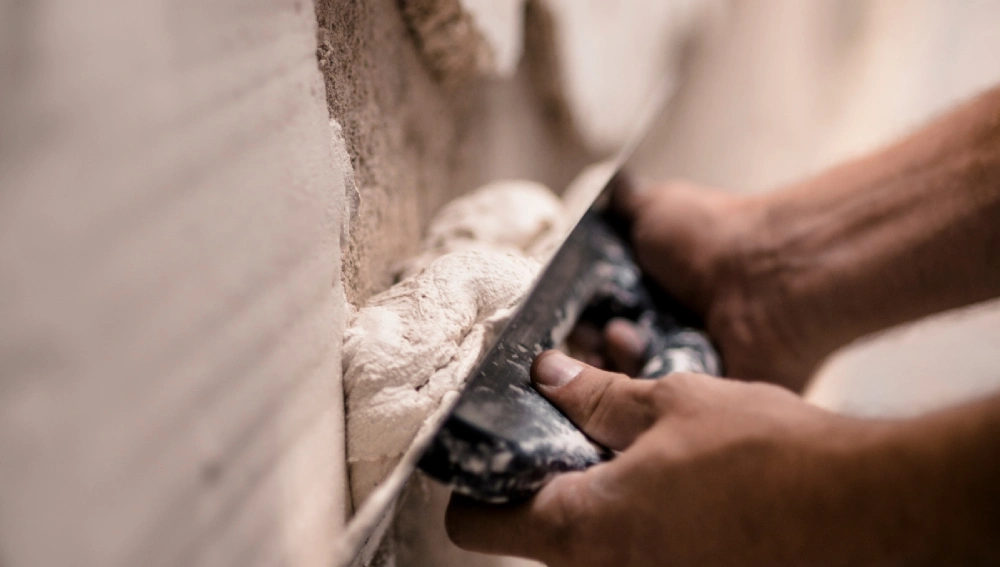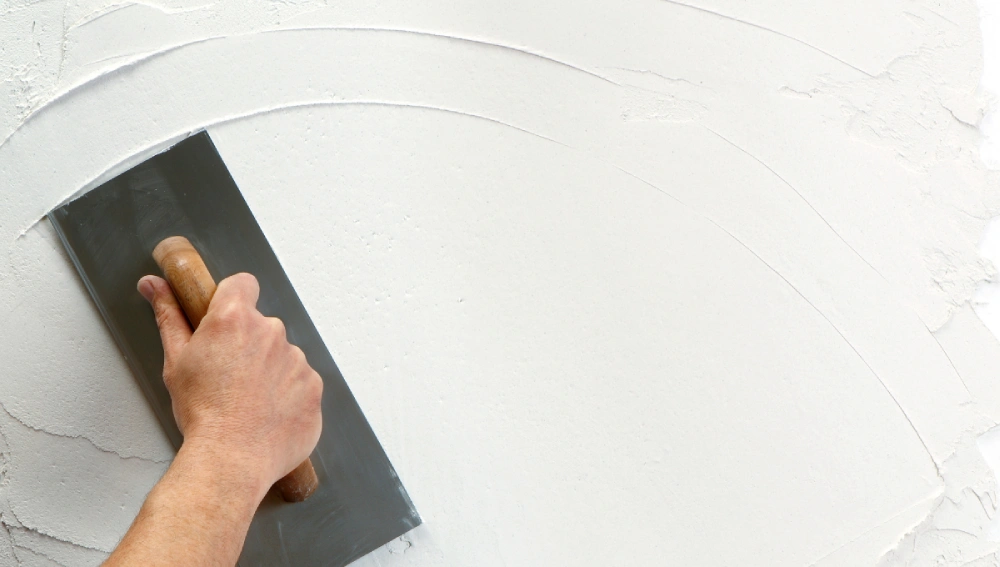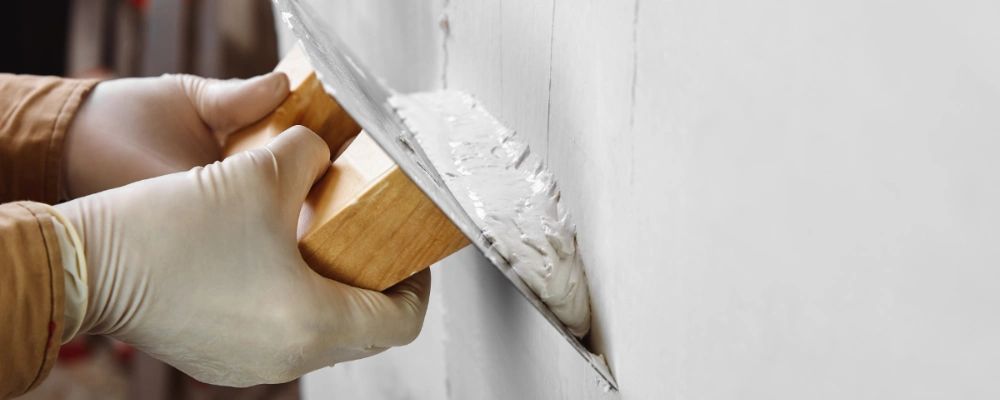Plastering plays a key role in construction and interior design. In earlier days, OPC and lime were used by builders to plaster. It gives a smooth, good-looking finish to walls and ceilings. But in recent years, white cement has become a popular choice. It has special features and looks better. This article will look at how to use white cement for plastering. We’ll talk about its plus points, where to use it, and give you step-by-step tips to use it well.
What is White Cement?

White cement is a type of Portland cement that is characterized by it’s raw materials with low iron and magnesium content, giving it a unique white color. This makes it popular for architectural finishes where looks matter. White cement production follows a process similar to grey cement but needs more careful manufacturing techniques to keep its color and quality. It includes:
- Using high-purity raw materials.
- Maintaining specific temperature conditions during clinker formation to prevent color contamination.
Benefits of Using White Cement for Plastering
White cement plastering has several advantages over traditional plastering materials:
1. Looks Good
White cement creates a smooth and bright finish, making the plastered surface look better. It works well for decorative plastering and can serve as a base for different finishes like paint, textures, and other coatings.
2. High Reflectivity
White cement reflects light well, making it a great pick for indoor spaces. It can make rooms look bigger and brighter. This feature is helpful in areas that don’t get much natural light.
3. Durability
White cement plaster long-lasts and stands up to the weather. It sticks well to what’s underneath, so it stays put and doesn’t need much upkeep.
4. Versatility
You can use white cement on many surfaces, like concrete, brick, and blockwork. It also works well with different decorative finishes, so you can use it for lots of things.
5. Smooth Finish
White cement gives a smooth and even finish, decreasing the need to add more finishing layers. This helps save time and reduce labor costs when plastering.
6. Resistance to Stains and Cracks
White cement plaster is better resistant to stains and cracks than regular plastering materials. Its formulation helps lower the odds of shrinkage cracks and keeps its clean look.
Ways to Use White Cement Plaster

You can use white cement plaster for many things, both inside and outside:
1. Inside Walls and Ceilings
This white cement plaster provides smooth and beautiful surfaces, and interior walls and ceilings can look great. It is 100% suitable for home, work, and social places.
2. Exterior Walls
White cement plaster is used on exterior walls, giving them strength and protection from the weather. It creates a clean, bright look that can boost a building’s curb appeal.
3. Decorative Plastering
People prefer white cement for decorative plastering because it’s flexible and can create diverse textures and patterns. You can use it to make different finishes, like rough, smooth, or textured surfaces.
4. Repair Works
White cement plaster works well for repairs, helping to fix damaged or cracked surfaces. Its smooth finish can blend in with the existing plaster, giving it a uniform look.
How to Use White Cement for Plastering
White cement plastering will involve The preparation of the surface, multiple coats, and the final coat. Here below are the procedures that are undertaken while applying white cement for plastering:
1. Getting the Surface Ready
For the creation of superior-quality plaster, a proper treatment should be given to the surface. You must check that the surface does not consist of any kind of soil, dust, or mud. It is always necessary to fill the holes and cracks, with the pre-plastering process, before beginning plastering work. Grout and white cement fill up the cracks in walls and tiles more effectively.
2. Mixing the Plaster
To make plaster, mix white cement, fine sand, and water in the right proportions. You’ll usually want 1-part white cement for every 3 parts of sand, but this can vary depending on what your project needs. Make sure you mix everything well to get a smooth, easy-to-use paste.
3. Application of the Plaster
Spread the plaster evenly across the surface using a trowel or other plastering tool. Make sure that every layer has the same thickness as you work your way up from the bottom. This helps avoid bumpy spots.
4. Finishing Smoothly
After applying the plaster, use a straight edge or trowel to smooth the surface. This helps make the surface even and gets rid of extra plaster. You can use a spirit level to check the flatness.
5. Letting the Plaster to Cure
Let the plastered area cure properly by keeping it damp for at least one week. It makes sure the plaster gets enough strength and durability. You can do this by spraying water on it or covering it with wet burlap or plastic sheets.
6. Finishing
You can finish it to acquire the desired appearance once the plaster dries. This may include, Adding paint or other ornamental accents, generating textures or patterns, and using sandpaper to smooth out any imperfections.
Tips for Making White Cement Plastering Successful
Here are some pointers to help you succeed with white cement plastering:
1. Pick Fresh Supplies
Make sure to use fresh white cement and sand when you mix your plaster. Old or out-of-date materials can hurt the plaster’s quality and strength.
2. Maintain Proper Thickness
The plaster mix needs to be of optimal plaster thickness, to make it easy to apply and stick well. A mix that’s too dry may crack, while one that’s too wet could sag.
3. Minimize Overworking
Working the plaster too much when you’re applying can make it not stick and cause problems on the surface. Apply the plaster with even strokes, and don’t trowel it too much.
4. Ensure Proper Curing
The secret to strong and durable plaster is to let it cure properly. Keep the surface moist, for the recommended duration.
5. Use Good Sand
The quality of the sand in the plaster mix can influence the result. To get a smooth and even surface, use fine, clean sand without impurities.
Common Issues and Solutions in White Cement Plastering
White cement plastering can run into some typical problems even with careful planning and execution. Here are some issues and how to fix them:
1. Cracking
Cracks can happen because of improper curing, wrong mix ratios, or quick drying. To avoid cracks, make sure to cure, use the right mix ratio, and don’t work in extreme temperatures.
2. Efflorescence
White, powdery deposits on plastered surfaces happen because of salt migration. We call this efflorescence. You can stop it by using cement with low alkali, making sure you waterproof well, and keeping good drainage.
3. Uneven Surface
For a flawless finish, use a straight edge to level the plaster after applying it in even layers. You run the risk of having an uneven surface if you don’t level or apply the plaster uniformly.
4. Poor Adhesion
If the plaster mix is too dry or you have not properly prepared the surface, the plaster may not adhere well. Before applying the plaster, make sure the surface is both clean and slightly damp. Also, get the mix consistency right.
Conclusion
White cement offers many uses and aesthetically appealing solutions, for plastering. It influences durability, gives a smooth look, and reflects light well, to get good results when plastering with white cement, For better results you need to use the right methods of Plastering. White cement plaster works well for both inside and outside applications, It can make your walls and ceilings look beautiful, apart from keeping them in good shape for a long time. These characteristics make it suitable for use in construction, especially during the repair and renovation of structures.

